Famiglia : Labridae

Testo © Giuseppe Mazza
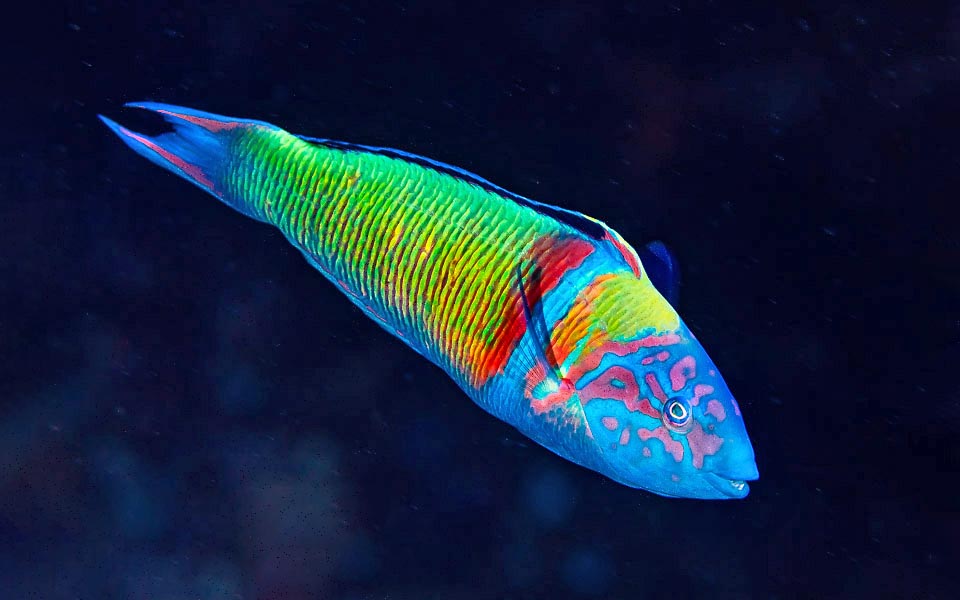
Presente anche lungo la costa atlantica dal sud del Portogallo al Golfo di Guinea, la Donzella pavonina (Thalassoma pavo) è uno dei pesci più vistosi del Mediterraneo © Raimundo Fernandez
La Donzella pavonina (Thalassoma pavo Linnaeus, 1758) appartiene alla classe degli Actinopterygii, i pesci con le pinne raggiate, all’ordine dei Perciformes ed alla famiglia dei Labridae.
Il nome del genere Thalassoma viene dal greco “thalassa”, mare, e “soma”, corpo; è quindi un animaleche ha il colore del mare.
Il nome specifico pavo, dal latino pavone, indica che si tratta di un pesce molto bello.
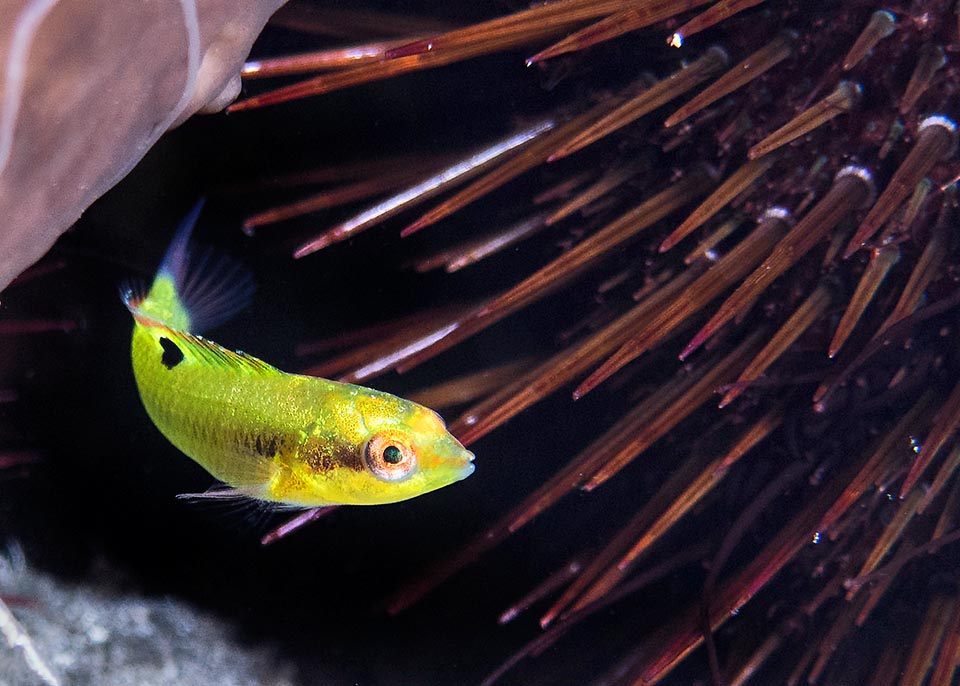
Ma per arrivare alla livrea qui sopra, dello spettacolare maschio terminale, il percorso è lungo e sorprendente. All’inizio i giovani sono gialli con una macchia nera sul dorso © Rafi Amar
Zoogeografia
È presente nelle zone più calde del Mediterraneo, ma in modo particolare lungo la costa atlantica dal sud del Portogallo al Golfo di Guinea.
Si trova anche in varie isole non lontane, come le Canarie, le Azzorre, e Madera.
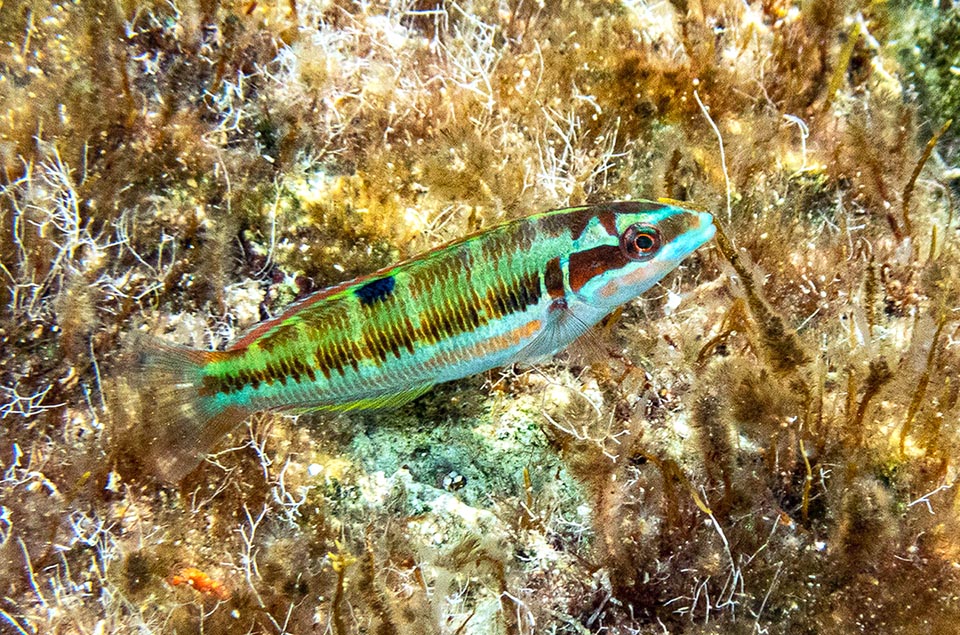
Questa macchia permane anche nella livrea giovanile successiva. Qui si stanno formando le 5 caratteristiche fasce verticali chiare, ma mancano gli eleganti disegni del capo © Stefanos Michael
Ecologia-Habitat
Specie costiera, la incontriamo sui fondali rocciosi fino a 20-30 m circa di profondità, ma in certe zone è stata avvistata anche verso i 100-150 m.
Morfofisiologia
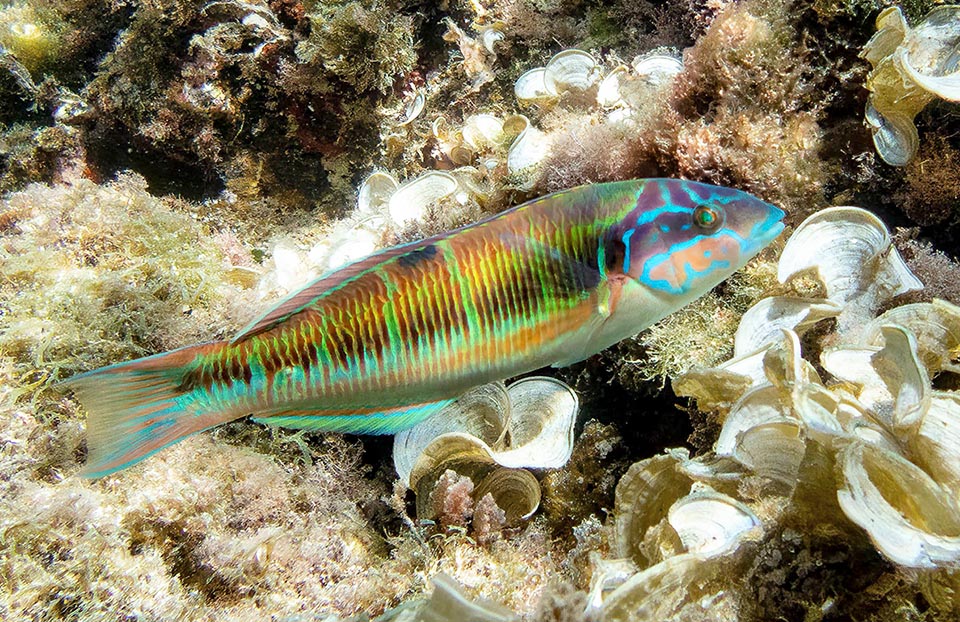
Si giunge così alla livrea intermedia che corrisponde a quella delle femmine, e trattandosi di una specie ermafrodita proteroginica, queste possono crescendo trasformarsi in maschi. Ma potrebbe trattarsi anche di un individuo in crescita nato già maschio. È la livrea che in passato aveva dato origine a Thalassoma pavo varietà unimaculata © Jean-Marie Gradot
La donzella pavonia raggiunge i 18 cm nelle femmine ed i 25 cm nei maschi. Il corpo, fusiforme, compresso sui lati, mostra una lunga pinna dorsale ed un’anale simmetrica molto più corta. La caudale è forcuta, e le pettorali, spatolate, sono più grandi delle ventrali. Il capo è privo di squame e la bocca molto piccola.
Secondo il colore si distinguevano tre varietà :
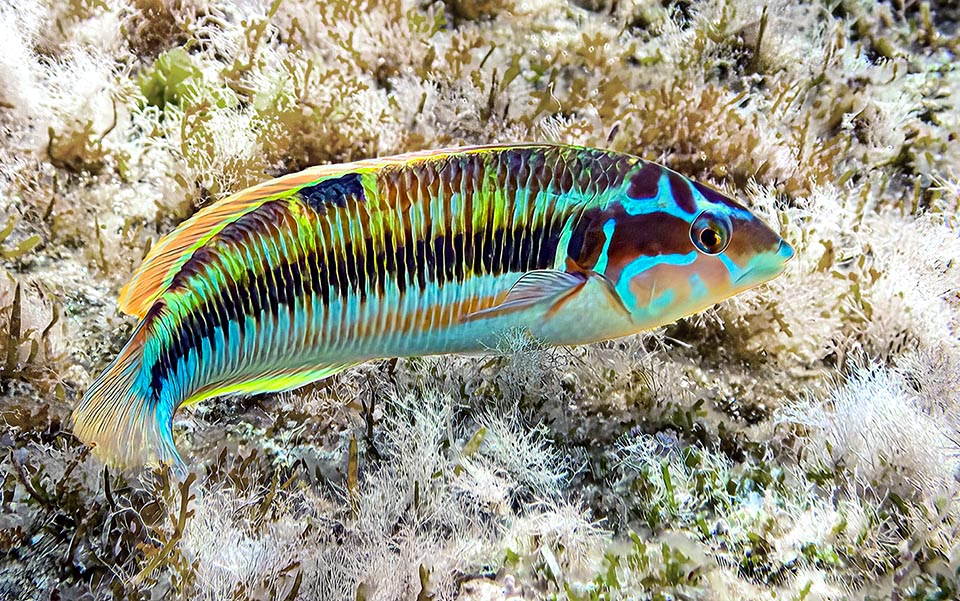
Questa è una livrea intermedia fra i due sessi, nota un tempo come Thalassoma pavo varietà lineolata © Stefanos Michael
– Thalassoma pavo varietà unimaculata Lowe, 1841, più frequente nelle zone fredde, con una macchia scura dorsale, e comunque più scuro nella parte alta del corpo. Verso il ventre spicca un po’ di rosso sulla struttura verticale verde-azzurra. Il capo non ha zone rosse, ma violacee.
– Thalassoma pavo varietà torquata Lowe, 1843, di maggiori dimensioni, più frequente nelle zone calde. La livrea è spettacolare con un contrasto spesso molto acceso fra l’azzurro e il rosso vivo del capo. Caratteristica è una banda azzurra verticale bordata di rosso, che separa questa zona dal resto del corpo, che tende al verde con macchie rosse. Reinboth dimostrò poi che si trattava esclusivamente di maschi.
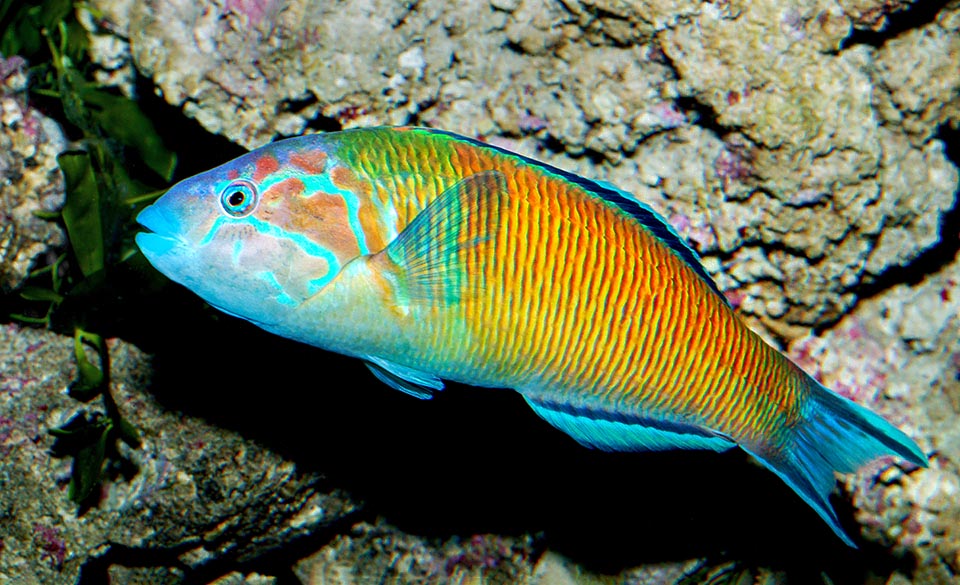
Qui si è ancor più vicini alla livrea maschile. È scomparsa del tutto la macchia nera dorsale e appare la tipica striatura rosso arancio che sfuma già verso il capo al verdastro © Giuseppe Mazza
– Thalassoma pavo varietà lineolata Lowe, 1841 che appare come la forma di transizione fra le due.
Oggi si parla, come per il Coris julis, di una specie ermafrodita proteroginica. Le femmine crescendo diventerebbero cioè maschi e la temperatura stimolerebbe il cambiamento di sesso. Ma la regola non è così stretta. Si è notato che alcune femmine non cambiano sesso e che certi maschi, detti iniziali, nascono già tali, ma non hanno come gli altri pretese territoriali e non sempre manifestano la colorazione terminale.
Etologia-Biologia Riproduttiva
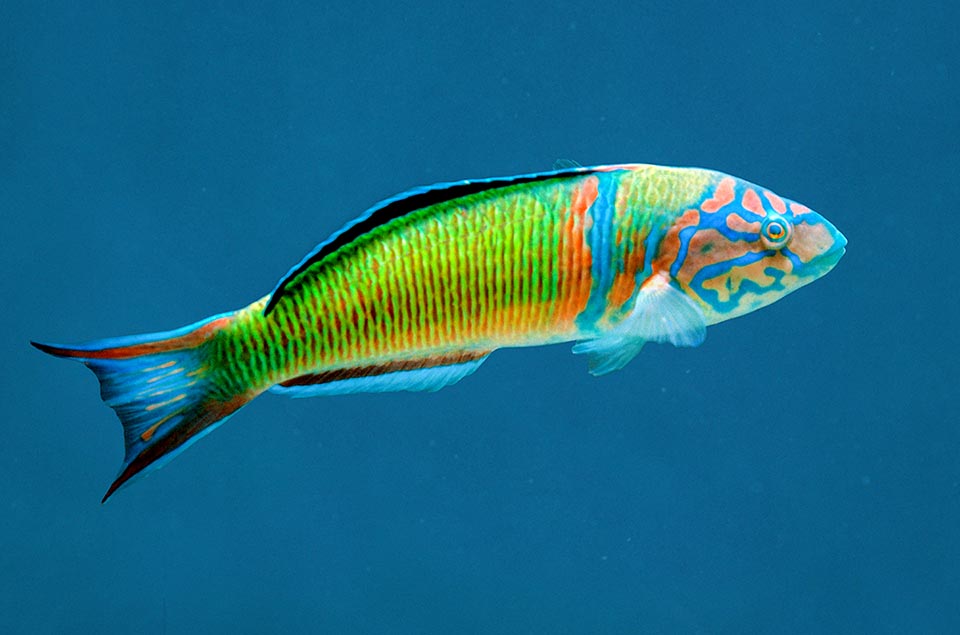
Siamo così giunti alla livrea maschile, nota un tempo come Thalassoma pavo varietà torquata. Caratteristico l’abbinamento di fasce e disegni rossi e blu © Giuseppe Mazza
La donzella pavone si nutre principalmente di piccoli molluschi e crostacei, ma anche d’uova. In particolare sorveglia la deposizione delle Castagnole (Chromis chromis) e quando viene scoperto un nido sui fondali di formano subito assembramenti famelici.
Quando è minacciata, per dormire o nei periodi freddi si rifugia sotto la sabbia.
Si può incontrare solitaria o in piccoli gruppi. La riproduzione avviene in giugno-luglio. I maschi con la colorazione terminale si battono fra loro per una zona rocciosa a 5 m circa di profondità e il vincente, dopo averli scacciati, vi fa entrare le femmine e feconda in nuoto le uova planctoniche. I maschi iniziali talora s’intrufolano fecondando di nascosto quello che possono.
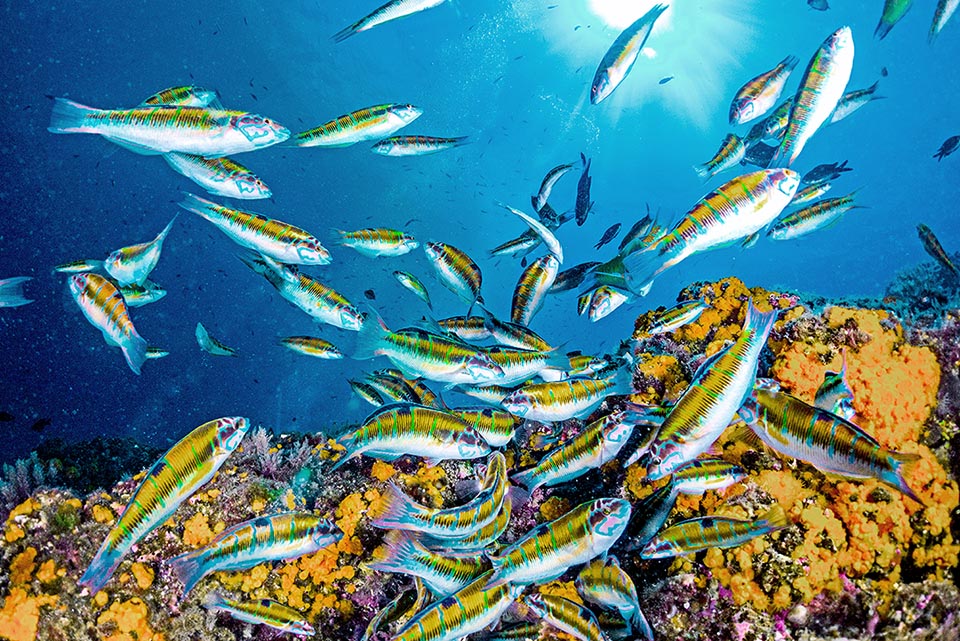
Le femmine e i giovani sono ovviamente più numerosi. Thalassoma pavo si nutre di piccoli molluschi e crostacei, ma anche d’uova, qui scoperte in un nido di Castagnola © Rosa Carrapiso
Molto richiesta per gli acquari, la Donzella pavonina viene spesso catturata con reti e nasse, e in vasche di dimensioni adeguate si adatta molto bene alla vita in cattività.
La resilienza della specie è mediocre, con un possibile raddoppio delle popolazioni in 1,4-4,4 anni, e l’indice di vulnerabilità alla pesca è basso, segnando 21 su una scala di 100.
Thalassoma pavo figura dal 2008 nella Lista Rossa delle specie in pericolo come “Least Concern” cioè come “Preoccupazione Minima”.
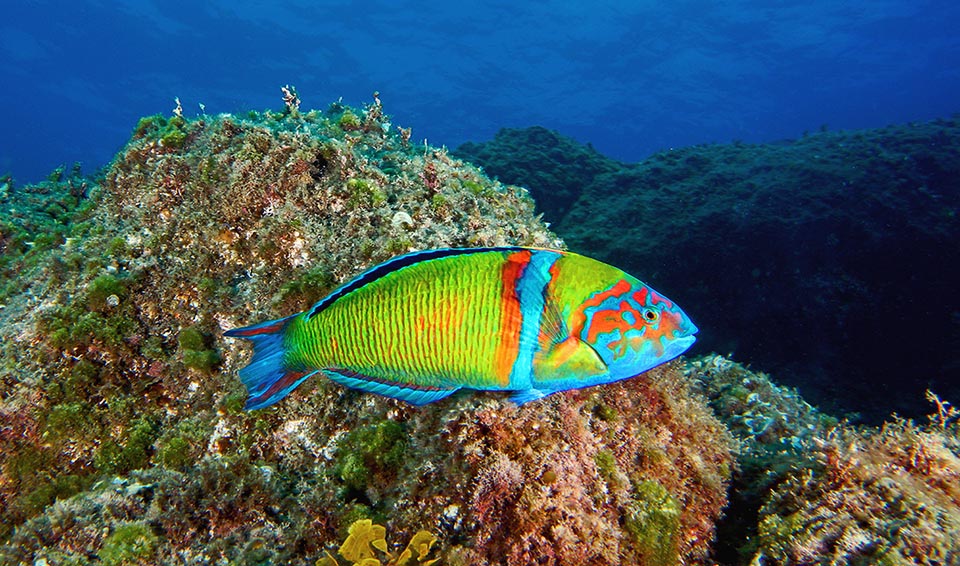
Nei maschi maturi, che possono raggiungere i 25 cm di lunghezza contro i 18 delle femmine, i colori s’intensificano notevolmente e diventano una bandiera per farsi notare dai rivali e difendere il luogo roccioso scelto per l’accoppiamento. Vi fanno entrare solo le femmine e fecondando le uova a mezz’acqua © Jaime Ezequiel Rodríguez Riesco
Sinonimi
Chlorichthys pavo Linnaeus, 1758; Julis blochii Valenciennes, 1839; Julis pavo Linnaeus, 1758; Julis squamismarginatus Bowdich, 1825; Julis turcica lemniscata Lowe, 1843; Julis turcica torquata Lowe, 1843; Julis turcicia Risso, 1827; Julis unimaculata Lowe, 1841; Julis unimaculata lineolata Lowe, 1841; Julis unimaculata taeniata Lowe, 1841; Julis vulgaris Valenciennes, 1843; Labrus leo Rafinesque, 1810; Labrus pavo Linnaeus, 1758; Labrus syriacus Bloch & Schneider, 1801; Thalassoma pavo lemniscata Lowe, 1843; Thalassoma pavo taeniata Lowe, 1841; Thalassoma pavo torquata Lowe, 1843; Thalassoma unimaculatum Lowe, 1841.
→ Per nozioni generali sui PESCI cliccare qui.
→ Per nozioni generali sui PESCI OSSEI cliccare qui.
→ Per nozioni generali sui PESCI CARTILAGINEI cliccare qui.
→ Per apprezzare la BIODIVERSITÀ dei PESCI OSSEI cliccare qui.
→ Per apprezzare la BIODIVERSITÀ dei PESCI CARTILAGINEI cliccare qui.
